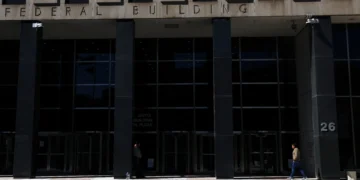- Vivek Ramaswamy described the policy as a means of “streamlining bureaucracy” by making federal jobs less appealing to those who value flexible work arrangements.
- He estimated that roughly a quarter of federal employees would voluntarily leave their positions if such measures were imposed.
- Ramaswamy’s presumption that fewer employees automatically equate to better governance oversimplifies the complexity of federal operations and risks undermining critical public programs.
The incoming Trump administration’s initiative to mandate a full-time return to the office for federal employees has ignited heated debate over its practicality and implications for government efficiency.
Spearheaded by entrepreneur and former presidential candidate Vivek Ramaswamy, who has been tapped to lead the newly proposed Department of Government Efficiency (DOGE), the plan seeks to reduce the federal workforce through a strategy designed to prompt mass resignations.
In an interview with Tucker Carlson, Ramaswamy described the policy as a means of “streamlining bureaucracy” by making federal jobs less appealing to those who value flexible work arrangements.
However, critics argue that this approach would squander taxpayer money, disrupt essential government functions, and undermine the quality of public service delivery, as highlighted in a recent Office of Management and Budget (OMB) report.
Ramaswamy’s vision hinges on eliminating telework options and enforcing strict in-office attendance as a mechanism to drive attrition.
He estimated that roughly a quarter of federal employees would voluntarily leave their positions if such measures were imposed, reducing payroll costs without direct layoffs.
This “radical idea,” as Ramaswamy called it, was pitched as a way to shrink a federal workforce that he characterized as bloated and overreaching. However, Carlson raised concerns about the plan’s feasibility, pointing to the robust job protections afforded to federal employees, which make involuntary terminations notoriously difficult.
Ramaswamy brushed off these concerns, maintaining that revoking remote work privileges would naturally compel resignations.
Proponents of the plan argue that cutting the federal payroll, which stands at $110 billion annually, would lead to a leaner and more efficient government. They contend that reducing headcount will eliminate inefficiencies and curb excessive regulation.
Ramaswamy portrayed the move as a necessary step to dismantle bureaucratic inertia, asserting that many unelected federal employees create regulatory burdens that undermine legislative authority.
“If you simply require them to show up at the office Monday through Friday,” Ramaswamy stated, “a significant portion would choose to leave, simplifying government processes and reducing overhead.”
Despite these claims, the proposal appears economically shortsighted and operationally hazardous. The federal workforce of 2.2 million employees oversees a $6.1 trillion budget, meaning salaries account for just 1.8% of expenditures — a remarkably low overhead for such a vast operation.
These employees perform critical functions across agencies like Homeland Security, the Department of Education, and the Federal Reserve.
Forcing resignations at scale would create a talent vacuum in roles requiring specialized knowledge and skills.
The resulting need for recruitment, onboarding, and training of replacements would not only delay a return to full operational capacity, but also generate significant costs that could eclipse any perceived savings.
Furthermore, the abrupt loss of experienced personnel would disrupt ongoing projects, diminishing the efficiency and quality of public services.
This approach also disregards the proven success of remote work in the federal sector.
During the COVID-19 pandemic, telework enabled government agencies to sustain productivity while reducing operational expenses tied to physical office spaces.
OMB findings indicate that flexible work arrangements enhanced efficiency and cost-effectiveness.
Reversing these gains would necessitate substantial reinvestments in office infrastructure, including utilities, maintenance, and security, potentially nullifying anticipated payroll savings. Taxpayers would ultimately bear the burden of these avoidable expenses.
Ramaswamy has framed the initiative as part of a broader agenda to overhaul federal regulations. He suggested that cutting workforce numbers could invalidate up to 50% of existing rules, many of which he claims are crafted by unelected officials.
While this rhetoric may appeal to critics of federal bureaucracy, it overlooks the intricacies of governance and the essential role of institutional expertise.
Federal employees do more than draft regulations; they implement policies enacted by Congress, ensuring the smooth delivery of programs and services that millions of Americans depend on, from Social Security to disaster relief.
The human and economic costs of this policy extend beyond the immediate federal workforce.
Morale among remaining employees would likely deteriorate under increased workloads and eroded institutional knowledge, leading to further attrition and a self-perpetuating cycle of inefficiency.
Industries reliant on federal oversight would face delays and disruptions, imposing costs on businesses and state governments alike. These cascading effects would exacerbate waste and inefficiency rather than alleviate them.
Rather than resorting to a blunt-force approach aimed at workforce reduction, the government should pursue nuanced reforms that balance efficiency with service quality.
Modernizing outdated systems, embracing digital transformation, and leveraging the proven benefits of remote work are far more effective strategies for achieving cost savings and operational excellence.
Ramaswamy’s presumption that fewer employees automatically equate to better governance oversimplifies the complexity of federal operations and risks undermining critical public programs.
In forcing federal employees back to the office under the guise of driving resignations, this policy sacrifices functionality for optics.
Instead of creating a streamlined government, it threatens to dismantle the institutions that underpin national stability and public trust.
Clinging to outdated workplace paradigms in an era of demonstrated telework success is not just inefficient—it is economically reckless and a disservice to taxpayers.


 Dr. Gleb Tsipursky – The Office Whisperer
Dr. Gleb Tsipursky – The Office Whisperer Nirit Cohen – WorkFutures
Nirit Cohen – WorkFutures Angela Howard – Culture Expert
Angela Howard – Culture Expert Drew Jones – Design & Innovation
Drew Jones – Design & Innovation Jonathan Price – CRE & Flex Expert
Jonathan Price – CRE & Flex Expert















